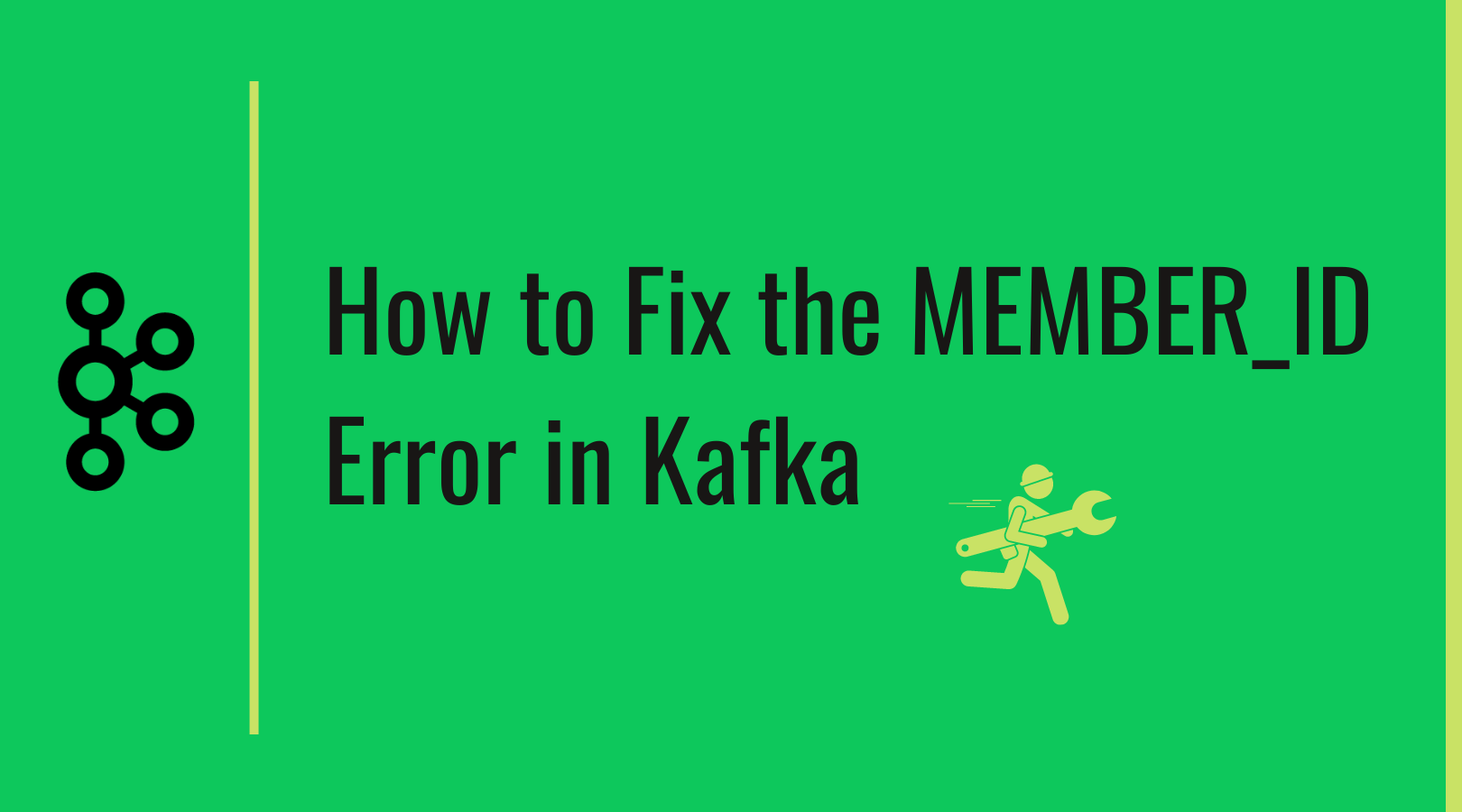Apache Kafka operates in a distributed system by forming Consumer Groups consisting of different Consumer instances. Before joining any such group, an instance must prove its identify with a valid Member ID. This step aids in maintaining synchronization among the participants throughout the data processing cycle.
| Terms | Definitions |
|---|---|
| Apache Kafka | A distributed streaming platform that handles real-time data feeds effectively. |
| Consumer Group | A design pattern within Apache Kafka that allows each consumer to read exclusive partitions of the topic in parallel. |
| Member ID | An identifier that each Consumer needs to have before actually entering into a Consumer group. |
Inside this setup, one entity known as the ‘Group Coordinator’ manages the Member IDs. When a new getting in the Consumer Group arises, it creates a temporary identity and requests for membership using this unique ID.
For executing the process, the pseudo code might be:
initialize TemporaryID; send JOIN_GROUP request to Coordinator with TemporaryID; on REJOIN response from Coordinator; //validating the temporary ID create actual MemberID; send another JOIN_GROUP request with actual MemberID; while waiting for final join group completion, submit rebalances; upon receiving SESSION_TIMEOUT exception, redo the entire operation;
After verifying the validity, the coordinator assigns a legitimate ID ensuring the authenticity of every subscriber involved in efficient data processing.
“Programs must be written for people to read, and only incidentally for machines to execute.” – Harold Abelson, Co-author of Structure and Interpretation of Computer Programs book
This quotation reflects the ideology behind designing a system like Kafka that emphasizes not just on machine-to-machine interaction but also human readability and management. Internally Apache Kafka uses such schemas that adhere to both humans and machines, making it a robust and effective data pipeline management system.
Understanding Kafka’s Core Requirement for Valid Member IDs in Consumer Groups

Apache Kafka, a distributed event streaming platform, operates using Consumer Groups that comprises various types of consumers. The core requirement of valid member IDs for these consumer groups is pivotal to functionality and performance within the Kafka ecosystem.
Understanding Member IDs in Kafka Consumer Groups
A Member ID in Apache Kafka is an identity assigned to every consumer with a consumer group. Primarily, this identifier assists in maintaining load balance between consumers by assenting the division of topic partition amongst them. Essentially, it ensures that each topic partition is consumed by exactly one consumer in any given group.
Equally important is the fact that valid member IDs help manage offsets – a crucial part of Kafka’s architecture. For instance, whenever a message is consumed from a topic partition, the offset or position of that consumed message gets updated under the consumer’s Member ID. This aids in providing resiliency, as in the event of a consumer’s failure, another consumer can take up from where the failed consumer left off.
So, what does Kafka mean when it says, “The group member needs to have a valid Member ID before actually entering a consumer group”? This requirement ties back to Kafka’s protocol where upon joining a consumer group, a consumer should present a valid Member ID. If the provided Member ID is invalid or non-existent, Kafka brokers will assign a unique one.
This trailing Member ID assignment process generally happens during the initial interaction of consumers with Kafka. As seen in the following Java code:
final KafkaConsumer<string, string=""> consumer = new KafkaConsumer<>(props);
consumer.subscribe(Arrays.asList("test-topic"));
</string,>
In the code snippet above, a new Kafka consumer is created and subscribed to the ‘test-topic’. Since this is the consumer’s first interaction, Kafka will assign a unique Member ID subsequently.
Justifying the importance of unique Member IDs, Melanie Warrick, a Senior Developer Advocate at Google once said, “It is all about data – both big and small. It is the engine that drives basic tasks like machine learning, analytics, and high priority business solutions.” With Kafka, having valid Member IDs plays a significant role to handle such extensive data efficiently across consumer groups.
Data consistency, fault-tolerance, and scalability are grand promises made by Kafka that anchors on the principle of ensuring valid Member IDs in its consumer groups. Having understood this requirement, it establishes a solid foundation on operating Kafka consumer groups optimally and keeping your data stream flowing robustly. Take a look at the Apache Kafka documentationhere for more detailed insight.
Delving Into The Process of Assigning Member ID Before Joining a Kafka Consumer Group

When venturing into the complexities of working with Kafka and consumer groups, a pivotal aspect of consideration is the assignment of member IDs prior to joining a Kafka Consumer Group. Comprehending this feature requires a grasp on two principle concepts: Kafka’s functioning model and the significance of the process of assigning a member ID.
To delve into the workings of Apache Kafka, it operates based on a publish/subscribe messaging paradigm. It deals with real-time streams of records that are produced to topics by producers and consumed from these topics by consumers. A consumer group in Kafka constitutes multiple consumers that jointly consume data.
KafkaConsumer<string, string=""> consumer = new KafkaConsumer<>(configs); </string,>
When a new consumer tries to join a consumer group, it sends a JoinGroup request without a member ID (i.e., empty string), since it is getting connected for the first time. Kafka’s protocol describes this as a situation when ‘the group member needs to have a valid member id before actually entering a consumer group’. The reason behind this prerequisite is simple yet critical – it aids in managing consumer groups and tracking each member within it. Once the JoinGroup request is accepted by the GroupCoordinator, a unique member ID gets assigned and returned to the consumer.
The following block of code demonstrates what an initial JoinGroup Request might look like:
JoinGroupRequest.Builder requestBuilder = new JoinGroupRequest.Builder( group, sessionTimeout, "") .setRebalanceTimeout(rebalanceTimeout) .setProtocolType(protocolType) .setGroupProtocols(protocols);
When rejoining, the consumer uses the member ID it received from the previous join. But if the client crashes and tries to rejoin with the old member ID, the coordinator will reject it because it has likely detected the crash and removed the member from the group.
As per KIP-345, Kafka’s improvement proposal, the introduction of static membership intends to mitigate the cost of rebalances, thereby improving the overall experience. Consequently, recognizing the importance of member IDs holds considerable significance.
As renowned MIT computer scientist, Michael Stonebraker mentioned,
“Big Data is all about turning assets into insights.”
This is embodied in how Kafka utilises member IDs, which highlight Kafka’s continual innovation in processing large amounts of information efficiently and effectively.
Unpacking the Significance of Valid Member IDs within Kafka’s Consumption Strategy

Kafka, an open-source, distributed streaming platform, relies heavily on unique identifiers to manage the performance and efficiency of its consumption strategy. When discussing consumer groups in Kafka, valid member IDs play a critical part. Understanding why each group member needs to have a valid member ID before actually entering a consumer group is fundamental to grasp Kafka’s design and working mechanism.
A ‘member ID’ in Kafka is a unique identifier assigned to a consumer within a group. Consumers in a Kafka consumer group are primarily responsible for consuming data from one or more Kafka topics. The member ID works as an authentication measure to discern various consumers within that group. For these reasons:
- Increased Efficiency: Having a valid member ID ensures that incoming messages are efficiently dispersed among all the members of the consumer group. The Kafka broker uses these identifiers to evenly distribute the data load.
- Balances Consumption: Each valid member ID helps Kafka in performing ‘Consumer Group Management’. It aids in retaining the group harmony by ensuring equal distribution of message consumption.
- Failover Support: In case a consumer shuts down or encounters an error, a distinct and valid member ID enables Kafka to reassign its data to another active consumer.
The assignment workflow of Kafka, which uses consumer group protocols, ties to the above points. The protocol includes two key stages:
JoinGroup
and
SyncGroup
. At the JoinGroup phase, a
null
MemberID signifies a new consumer aspiring to join the group. Once acknowledged, Kafka assigns a proper MemberID, which is mandatory for the SyncGroup stage where member assignment occurs.
#### Excerpt from Apache Kafka (source):
"When a new consumer joins a consumer group the group goes through a 'rebalancing' process to assign partitions to each consumer. If the set of consumers changes while this assignment process is taking place the rebalance will fail and retry. This setting controls the maximum number of attempts before giving up."
Hence, illustrating why a valid member ID holds significant value within Kafka’s consumption strategy.
As Miško Hevery, the co-author of AngularJS Framework once quoted,
“The best error message is the one that never shows up”.
By enforcing the necessity for each member of the group to bear a valid member ID, Kafka eliminates potential pitfalls such as data overlap or incorrect message routing, making error messages less likely to surface, thereby improving the overall resilience and stability of your application.
Implementing Pre-emptive Measures to Ensure Valid ID Prioritization in Your Kafka Consumer Group
![]()
In the digitized, distributed messaging world of Apache Kafka, there exists an inevitable need for ensuring valid ID prioritization within your consumer group. A common challenge faced by developers revolves around the crucial requirement that a group member must have a valid member ID before truly becoming part of a Kafka consumer group.
The crux of the issue is about order and precedence – designating how consumers are arranged and prioritized based on their identifier (ID). This notion warrants a shift towards preemptive measures that ensure the validation of IDs prior to incorporating them into a consumer group.
- Double Validation:
Before sending off a request to join a group, the kafka consumer can execute a pre-check for verification.if (validMemberID (memberID)) { // Execute code to join group } else { // Log error or alert }Here, validMemberID() would be a method to validate the member’s ID against whatever criteria defined. Double validation provides an additional layer of assurance that only eligible members are added to the respective groups.
- Dedicated Validation Service:
Consider developing a small middleware service which acts as a gatekeeper, scrutinizing member IDs prior to initiating Kafka group protocols. Again, this offers twofold protection, especially beneficial in intricate systems where improper ID assignment could lead to catastrophic outcomes.
As Deutsche Telekom’s Senior Vice President of Engineering and Innovation, Thomas Saueressig, once said, “Technological innovation is indeed important to economic growth and the advancement of human knowledge.” Our aim is to capitalize on such advancements to address issues like valid ID prioritization in Kafka consumer groups, ultimately driving efficiency and performance.
Remember, it’s integral to thoroughly understand the exact requirements, constraints, and potential trade-offs when implementing any new mechanism. Testing plays an essential role in validating how these changes affect the overall system engineering, performance, and consumer rebalancing behaviour.
For further reading on robust Kafka implementation, you may find [Apache documentation](https://kafka.apache.org/documentation/) valuable, enriched with copious details regarding architectural patterns and best coding practices concerning Kafka environments.
In the realm of Kafka, a pivotal point to consider is the requirement of a valid member id for an individual to enter a consumer group. Apache Kafka uses this member ID as an identifier in its consumer groups to track and manage consumer instances. Without a valid ID, Kafka cannot effectively function, as it’s unable to correlate consumers to their respective tasks.
Kafka Consumer Group’s fundamental protocol focuses on the significance of having valid member IDs for successful operation. The emphasis on such necessity is primarily due to two main reasons:
1. To ensure accurate tracking: A unique member id allows Kafka to accurately locate and track individual consumers within a consumer group. This tracking helps maintain message delivery consistency and assure that each message reaches its assigned consumer.
2. Maintaining uniformity: As Kafka is fundamentally based on distributed systems, maintaining some level of orderliness or consistency across varying nodes is crucial. Using unique member IDs for every consumer aids in keeping the system organized and coherent.
The following is how Kafka provides a valid Member ID:
ConsumerConfig config = new ConsumerConfig(props); String memberId = config.groupId + "-" + UUID.randomUUID().toString();
Through the consumption of data from Kafka topics, consumer groups play an essential role in processing large volumes of real-time data. Therefore, it becomes paramount to have a precise mechanism in place, like a valid member ID, for comprehensive organization and tracking.
Reflecting on Apache Kafka’s philosophy articulated by Neha Narkhede, one of its co-creators, “By using Kafka, applications that were previously isolated can now communicate through a shared log.” It could be posited that in order to fulfil this vision of interconnected applications, the entry into Kafka Consumer Groups necessitates the verification against possession of a valid member ID.
Ensure you always verify and assign valid Member IDs to avoid complications with Kafka Consumer Groups.
